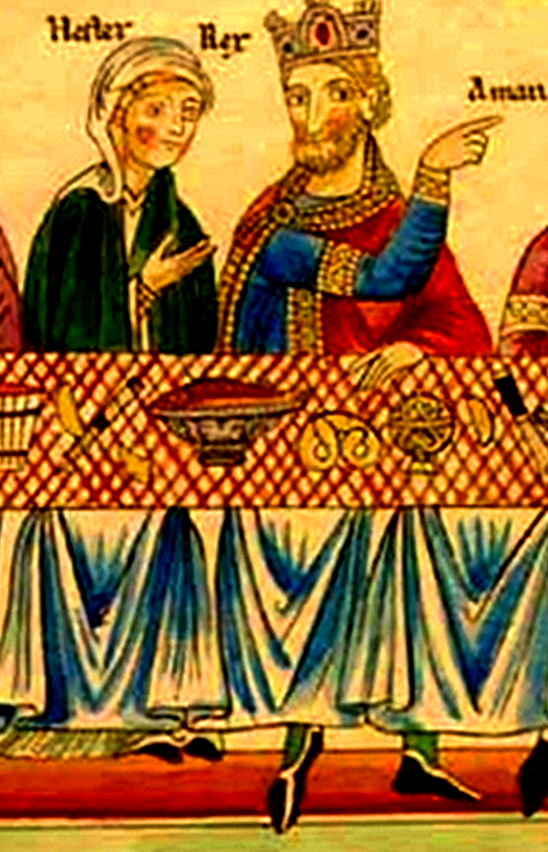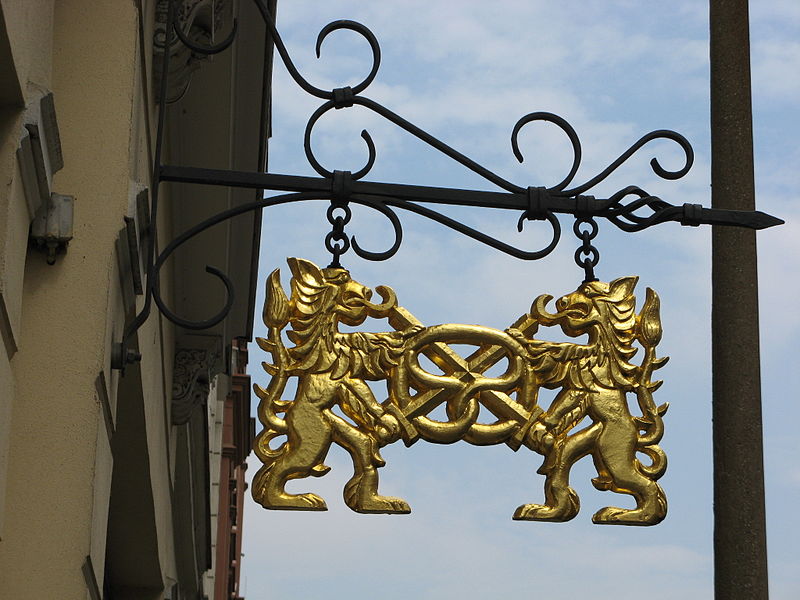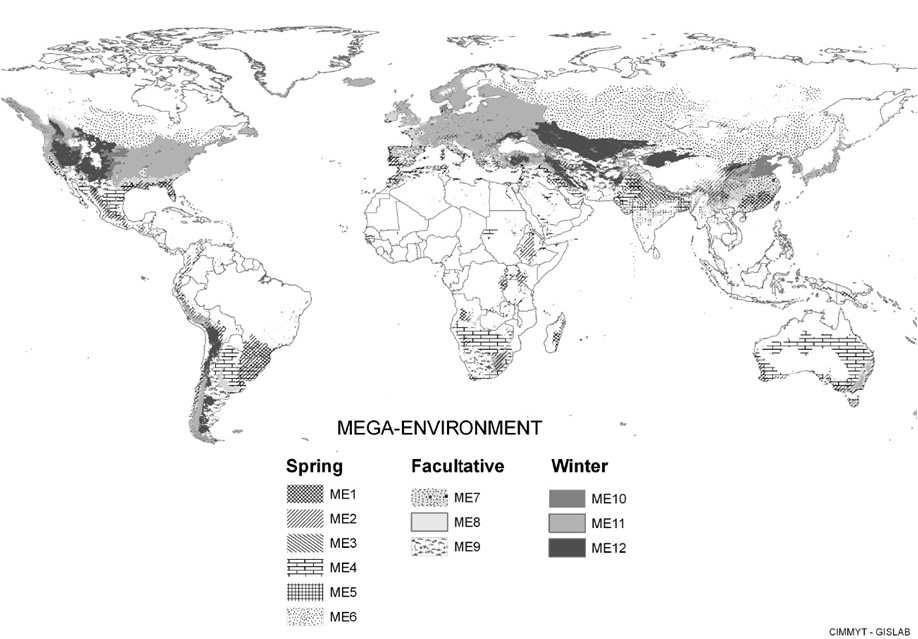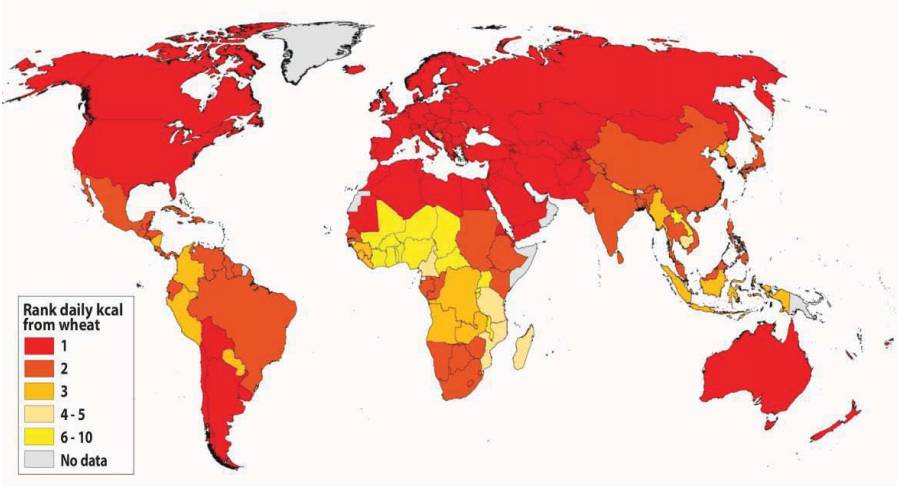Soft pretzels, Philly style, with sea salt flakes, and butter glaze. [Photo, TW Carns]
My friend E.J. from Pennsylvania says these are the real deal. Having never eaten a Philly pretzel, I have no way of telling, but the ones he made sure tasted good, so I tried his recipe.

Painting from Alsace, 12th century C.E., may be the earliest picture of a pretzel (on the table). From http://en.wikipedia.org/wiki/File:Hortus_Deliciarum_1190.jpg.
I reviewed pretzel recipes on a few web sites to see what the most important things about baking pretzels might be. Bottom line -- boil or dip them briefly, in an alkaline bath (made with baking soda or lye; here's a link to a discussion of the merits of each). That's what makes them pretzels rather than bread. Boiling them helps set the proteins on the outside, limiting how much they can rise in the oven. That gives them a texture that's denser and chewier than regular breads.
Photo, traditional pretzel twist, looking like arms across chest in a gesture of prayer. [How Stuff Works.]
I wondered what makes a bagel actually a bagel instead of a pretzel -- because you boil both of them. Historically, it appears that bagels descended from pretzels, a "Christian" bread, remade in Jewish ghettos in the Middle Ages and Renaissance. (Of course, others suggest that the pretzel itself descended from circular Pagan breads, made to represent the sun.)
Two answers to the bagel question were, a) some sweetening (often mixed into the dough), and b) some malt or malt syrup, either in the dough or in the water. I didn't have malt on hand, and impatient as always, didn't want to go out for it. One recipe recommended boiling the bagels in sweetened water, so I tried that, and sure enough -- they tasted bagel-ish, not pretzel-ish. On the other hand, as I read further, I found recipes for boiling bagels in water with baking soda (just like pretzels), or with nothing in the water, etc. So the answer to the question of why is it a bagel rather than a pretzel (besides the shape) remains ambiguous, like so many culinary questions.
E.J. Pavsek Philadelphia pretzel recipe - 5/19/2012
This recipe is a basic yeast dough -- flour, water, salt. You're kneading it; letting it go through a standard first rise (about an hour, until about doubled); cutting and shaping the dough (either pretzels or bagels); boiling it very briefly and draining it; baking in a hot oven; letting cool a bit before eating.
Ingredients
1 package dry yeast (or 2 1/4 tsp active dry yeast from a jar)
1 1/4 cup warm water
2 teaspoons salt
4 to 5 cups all purpose flour
4 teaspoons baking soda (for pretzels), 1 1/2 Tablespoons golden syrup (for bagels), in 4 cups boiling water
Kosher salt, coarse (or other toppings, as desired); melted butter if desired
How to make them
Make the dough
Dissolve yeast in 1/4 cup of the warm water, and let stand for about 10 minutes until foamy. Stir in the rest of the water (one more cup).
Mix 4 cups all purpose flour and salt in a large mixing bowl. Add the yeast in water and enough additional flour (or water, as needed) to make a stiff dough. As with any yeast dough, the proportions of flour and water will vary somewhat depending on the season, humidity, and so forth).
Knead, and let the dough rise
Knead dough for 10 minutes on lightly floured board OR until dough is elastic. Form the dough into a ball, coat lightly with butter, place in bowl. Cover the bowl loosely with plastic wrap and let rise for 45 minutes. Note that this dough only rises once.
Dough in bowl, ready to rise. Cover with a damp towel or lightly layer plastic wrap over it, to keep it from drying out. [Photo, TW Carns]
Shape and boil the pretzels/bagels
At the beginning of this step, shaping and boiling the pretzels/bagels, do these three things:
- Preheat oven to 475 degrees;
- Butter a baking sheet; and
- Bring to a boil 4 cups of water, and dissolve 4 Tablespoons of baking soda in it (for pretzels) or 1 1/2 Tablespoons of golden syrup (for bagels).
Shaped pretzels, ready to boil. [Photo, TW Carns]
Drop pretzels into boiling water; fish them out after 5 to 10 seconds using a slotted spoon (the surface will look a little dimpled). Drain them on paper toweling, briefly, and put them onto the buttered baking sheet.
Boiling the bagels, in 4 cups of water, with 1 1/2 Tablespoons of golden syrup added. The pretzels were boiled in 4 cups of water with 4 Tablespoons of baking soda added. [Photo, TW Carns]
Sprinkle with sea salt, to taste (Maldon flakes are a good size), or use kosher salt.
Boiled pretzels, sprinkled with salt and ready to bake. [Photo, TW Carns]
Bake for 8 to 12 minutes OR until golden (start checking at 6 minutes). Cool on a rack.
Pretzels, some salted and some not, cooling. Brush them with melted butter, if you like. [Photo, TW Carns]

Pretzel as bakers emblem, traditional in Goerlitz, Germany.
Historical notes
Easter: Besides being a Lenten food, in some places a pretzel was hidden, along with two hard-boiled eggs, for people to find on Easter.
Weddings: Pretzels were associated with marriages as well. One site notes that the knotted shape represented the binding of the two parties, or, "Tying the knot." "Weddings in Europe for a time used the tradition of the bride and groom tugging at a pretzel like a wishbone, the larger piece assured the spouses fulfillment of their wishes."
Coming to the United States: From foodtimeline.org, under "Pretzels -- "The Dutch probably brought the pretzel to America, and there is a story that in 1652 a settler named Jochem Wessel was arrested for using good flour to make pretzels to sell to the Indians at a time when his white neighbors were eating bran flour. The first mention of the word 'pretzel' in American print was about 1824, and the first commercial pretzel bakery in the United States was set up in 1861 by Julius Sturgis and Ambrose Rauch in Lititz, Pennsylvania. Most pretzels are twisted by machine, introduced in 1933." ---Encyclopedia of American Food and Drink, John F. Mariani [Lebhar-Friedman:New York] 1999 (p. 255-6)
Jacob Fobsen Van Es Déjeuner Nancy (1596–1666).
































































